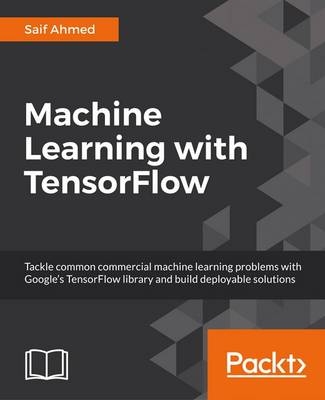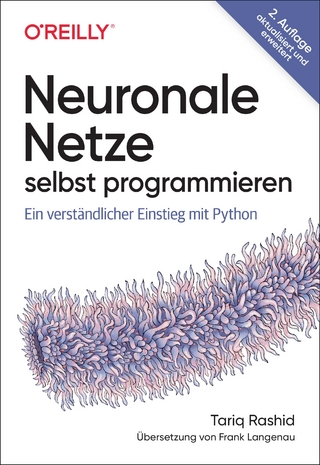
Machine Learning with TensorFlow 1.x
Packt Publishing Limited (Verlag)
978-1-78646-296-1 (ISBN)
About This Book
• Enter the new era of second-generation machine learning with Python with this practical and insightful guide
• Set up TensorFlow 1.x for actual industrial use, including high-performance setup aspects such as multi-GPU support
• Create pipelines for training and using applying classifiers using raw real-world data
Who This Book Is For
This book is for data scientists and researchers who are looking to either migrate from an existing machine learning library or jump into a machine learning platform headfirst. The book is also for software developers who wish to learn deep learning by example. Particular focus is placed on solving commercial deep learning problems from several industries using TensorFlow's unique features. No commercial domain knowledge is required, but familiarity with Python and matrix math is expected.
What You Will Learn
• Explore how to use different machine learning models to ask different questions of your data
• Learn how to build deep neural networks using TensorFlow 1.x
• Cover key tasks such as clustering, sentiment analysis, and regression analysis using TensorFlow 1.x
• Find out how to write clean and elegant Python code that will optimize the strength of your algorithms
• Discover how to embed your machine learning model in a web application for increased accessibility
• Learn how to use multiple GPUs for faster training using AWS
In Detail
Google's TensorFlow is a game changer in the world of machine learning. It has made machine learning faster, simpler, and more accessible than ever before. This book will teach you how to easily get started with machine learning using the power of Python and TensorFlow 1.x.
Firstly, you'll cover the basic installation procedure and explore the capabilities of TensorFlow 1.x. This is followed by training and running the first classifier, and coverage of the unique features of the library including data flow graphs, training, and the visualization of performance with TensorBoard—all within an example-rich context using problems from multiple industries. You'll be able to further explore text and image analysis, and be introduced to CNN models and their setup in TensorFlow 1.x. Next, you'll implement a complete real-life production system from training to serving a deep learning model. As you advance you'll learn about Amazon Web Services (AWS) and create a deep neural network to solve a video action recognition problem. Lastly, you'll convert the Caffe model to TensorFlow and be introduced to the high-level TensorFlow library, TensorFlow-Slim.
By the end of this book, you will be geared up to take on any challenges of implementing TensorFlow 1.x in your machine learning environment.
Style and approach
This comprehensive guide will enable you to understand the latest advances in machine learning and will empower you to implement this knowledge in your machine learning environment.
Quan Hua is a Computer Vision and Machine Learning Engineer at BodiData, a data platform for body measurements, where he focuses on developing computer vision and machine learning applications for a handheld technology capable of acquiring a body avatar while a person is fully clothed. He earned a bachelor of science degree from the University of Science, Vietnam, specializing in Computer Vision. He has been working in the field of computer vision and machine learning for about 3 years at start-ups. Quan has been writing for Packt since 2015 for a Computer Vision book, OpenCV 3 Blueprints. Shams Ul Azeem is an undergraduate in electrical engineering from NUST Islamabad, Pakistan. He has a great interest in the computer science field, and he started his journey with Android development. Now, he's pursuing his career in Machine Learning, particularly in deep learning, by doing medical-related freelancing projects with different companies. He was also a member of the RISE lab, NUST, and he has a publication credit at the IEEE International Conference, ROBIO as a co-author of Designing of motions for humanoid goalkeeper robots. Saif Ahmed is an accomplished quantitative analyst and data scientist with 15 years of industry experience. His career started in management consulting at Accenture and lead him to quantitative and senior management roles at Goldman Sachs and AIG Investments. Most recently, he co-founded and runs a start-up focused on applying Deep Learning to automating medical imaging. He obtained his bachelor's degree in computer science from Cornell University and is currently pursuing a graduate degree in data science at U.C. Berkeley.
| Erscheinungsdatum | 29.11.2017 |
|---|---|
| Verlagsort | Birmingham |
| Sprache | englisch |
| Maße | 75 x 93 mm |
| Themenwelt | Informatik ► Datenbanken ► Data Warehouse / Data Mining |
| Informatik ► Theorie / Studium ► Künstliche Intelligenz / Robotik | |
| ISBN-10 | 1-78646-296-6 / 1786462966 |
| ISBN-13 | 978-1-78646-296-1 / 9781786462961 |
| Zustand | Neuware |
| Informationen gemäß Produktsicherheitsverordnung (GPSR) | |
| Haben Sie eine Frage zum Produkt? |
aus dem Bereich


